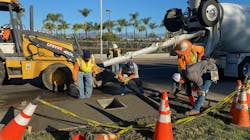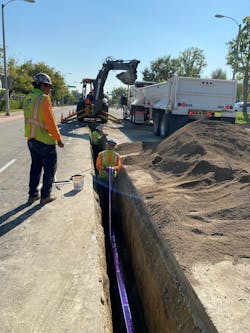Keeping up with drinking water demand in an era grappling with the impacts of climate change along with rapidly growing communities is a challenge for water agencies across the country. Solutions are vital, as water managers face questions about how to ensure sustainability of our water supply for generations to come.
California’s Rowland Water District is tackling these issues head on by seeking innovative partnerships that ensure a secure water future for the region — while also saving money for its customers. With a service area of 17.2 square miles in southeastern Los Angeles County, the district delivers drinking water to 58,000 customers; including 13,825 commercial, light industrial, and residential service connections.
When a new retail-hotel center began development in the area, the district entered a unique public-private partnership with the developer to meet new water needs.
The third year of historic drought in 2022 caused supply shortages to farms and cities, prompting calls for increased conservation — so finding a way to balance the added water needs of new developments was key to allowing projects to forge ahead.
Balancing Sustainability and Demand
Upon first review of the development proposal in 2015, it was clear that water scarcity and drought conditions would impact the district’s ability to supply the 90 acre-feet of potable water that would be required each year by the new development. Keeping its customers and long-term water sustainability in mind, Rowland Water knew that outside-the-box thinking would be needed for the project to move forward.
Using recycled water for irrigation and industrial purposes is a critical component of managing long-term water supplies. The practice diversifies water resources and reduces dependence on imported water, freeing up valuable drinking water for use by customers.
The district knew that by using the development to help expand its recycled water system, it could counterbalance the drinking water needs of the new shopping center and hotel development while supporting a lasting water supply for the region.
Under a $2 million agreement, funded entirely by the developer, the partnership built the Future 3 Project: a recycled water pipeline that connects to businesses at an existing retail development through a 1.5-mile extension of the district’s purple pipe system. The move offset more than 100 acre-feet of drinking water demand, saving existing businesses money by no longer forcing them to rely on valuable drinking water for irrigation.
Collaboration is Key
The developer financed a recycled water phase already identified in the Rowland Water District recycled water master plan, making the solution easier to put into action. The agreement included funding for the project’s pipeline design, onsite design, permitting, and construction. The project also included collaboration from the Los Angeles County Sanitation Districts, Metropolitan Water District of Southern California, County of Los Angeles, AKM Consulting Engineers, John Robinson Consulting Inc., and the City of Industry.
Project design began in 2020, followed by construction of the 8-inch recycled water mainlines serving 23 businesses. Connections to the new services were made to existing customer irrigation systems, followed by cross-connection testing with the health department — all at no cost to the customers.
The district’s staff was instrumental throughout the process and critical to the project’s success. Seeing the project through from start to finish included planning, customer engagement, design, and project management.
In addition to their top-notch team, a successful outcome required more than a unique partnership and dedicated staff. Gaining customer backing was key, and Rowland Water earned support and built public trust by listening to and collecting feedback from the community. Education and outreach were crucial to the process and included face-to-face meetings, informational mailers, and explanations of the benefits and expectations.
The project experience wasn’t easy, but it was worthwhile. Working as a team, all departments came together to use their knowledge and experience in retrofitting existing systems to recycled water.
Attention to Detail
During extensive project planning period, staff had to determine how and where to expand the system to reach the 100 acre-feet goal, evaluate feasibility, and draft designs. Additionally, the team conducted pre-construction surveys to identify backflow assembly information, the degree of retrofit difficulties, and the point of connection, size, and location of meters.
Project design was responsible for confirming specifications, requirements, and accuracy for 12 new system valves, 23 recycled water services, five air vacs, four blow off assemblies, and relocation of an existing potable water main through an easement.
In addition, the onsite retrofit required the installation of backflow prevention assemblies and the removal of irrigation backflow devices and services.
From project start to closeout, project management was crucial and required careful attention to detail throughout the permitting and pre-approval process, bid solicitation, and construction stages.
The Future 3 Project for the new retail-hotel center was completed in October 2021 at zero capital cost to the agency or its ratepayers. Thanks to collaboration and careful planning, Future 3 is meeting the water demand of the new development in Rowland Heights while also saving newly-converted recycled water customers $60,000 annually.
The Future 3 project is a testament to the success of using innovation and collaboration to expand resources, diversify water supplies, and ensure a sustainable water future. The experience confirms the value of exploring creative solutions to water supply challenges. WW
About the Author: Dusty Moisio is assistant general manager at Rowland Water District and holds certifications from the American Water Works Association (AWWA) as a Cross-Connection Control Specialist.
Published in WaterWorld magazine, June 2022.
About the Author
Dusty Moisio
Dusty Moisio is Assistant General Manager at Rowland Water District and holds certifications from the American Water Works Association (AWWA) as a Cross-Connection Control Specialist.

